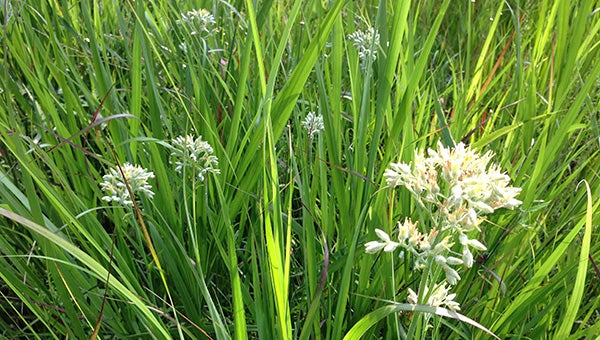Arboretum Paths: Plant diversity in the Savanna Exhibit
Published 7:00 am Wednesday, June 29, 2016

Redroot (Lacnanthes caroliana), occurs in the Arboretum’s south pitcher plant bog. Its seed is a favorite food of sandhill cranes (Image: Pat Drackett).
The plants found in the Arboretum’s south pitcher plant bog, to those unfamiliar with them, are often an eye-opening experience. It’s quite enjoyable to see others experience this variety of unusual and strikingly attractive blooms for the first time, which are so surprisingly different from the typical blooms found in gardening books and magazines.
Last Saturday’s field walk brought a group of enthusiastic participants ready to explore our garden, even on this hot day. We strolled the shady, forested Pond Journey path and emerged into the sunny South Savanna, and bombarded with a brilliant display of color and texture of the wildflowers. The wide array of summer blooms served to divert our attention from the sultry weather.
Here, butterflies sipped nectar from the flowers which included pink and yellow meadow beauty, lady’s hatpins, fewflower milkweed, false asphodel, yellow eyed grass, and pineland hibiscus. Yellow pitcher plants intertwined with the crazy quilt of color. White-top sedge, goldencrest, and redroot added tufts of gray and white, and emerging grasses provided a backdrop for the color display.
To a visitor to Pearl River County, or the Gulf Coast in general, the every-day scenery we are so accustomed to is often perceived in an entirely different manner. Coastal Mississippi offers an exotic destination to those who are fascinated by carnivorous plants, and look forward to taking a trip to our area to explore them.
Before our field walk, I reminisced on how different our landscapes are from those I grew up with, which was the crags and valleys of the nearby Smoky Mountains. This was awesome but familiar scenery, and taken for granted. Although people from all around the country came to experience the nearby national park, I longed for vacations to sandy beaches, and the chance to experience an entirely different environment.
Now that I no longer reside in Tennessee, my perspective has changed, and at times find myself longing for the once-familiar landscape. Paradise, they say, is awaiting you in your own back yard.
The “forest floor” at the Arboretum contains very little vegetation, lacking the floral carpet I would experience on springtime walks on mountain excursions. Spring in Tennessee is the season to celebrate wildflowers, when every square inch of the woods seems to be carpeted in blooms, moss, and ferns. Tapestries of fringed phacelia, trilliums, and Virginia bluebells by the thousands stretch as far as the eye could see along the pathways.
In Mississippi, our season for dramatic wildflowers is instead during the summer months, particularly in the wet pine savanna landscapes of our pitcher plant bog. These areas contain an extremely high diversity of plant species.
At the time of European settlement, wet pine savannas and the longleaf pine ecosystem stretched from coastal Virginia across the Gulf Coast to eastern Texas, an area of approximately 90 million acres. This area contained around 1,200 different species of plants which occurred here and nowhere else. Today, less than 5 % of this ecosystem remains. Human settlement has reduced the area to isolated fragments.
Take a look at the old photographs on the Internet of the longleaf pine forests in the early years. Try to imagine what these coastal landscapes appeared like hundreds of years ago, when the pine forests stretched unbroken across the coastal south. Visit the Arboretum and experience the fact that our public garden has preserved a 20-acre section of this wet pine savanna ecosystem, and interprets this landscape to our visitors.
A children’s workshop on insect exploration will be held Thursday, June 29, from 10:00 a.m. to noon with Hancock County Extension Agent Christian Stephenson. Cost for non-members’ children is $2. Children to be accompanied by parent or guardian (no charge for adults).
Our Aquatic Plant Sale will be Saturday, July 9, from 9:00 a.m. to noon. Explore a diverse selection of non-invasive native aquatic plants. Many are divisions from our exhibits. Site admission is free.
A Project Wild teachers’ workshop will be held on Thursday, July 14 from 9:00 a.m. to 3:00 p.m., led by outreach educatorSabrina Cummings, Mississippi Museum of Natural Science. Teachers and homeschool educators, call 601-799-2311 to register.
See www.crosbyarboretum.msstate.edu for more information. The Arboretum is open Wednesday throughSunday from 9 a.m. to 5 p.m. and located in Picayune, I-59 Exit 4, at 370 Ridge Road.
Patricia R. Drackett, Director and Assistant Extension Professor of Landscape Architecture
The Crosby Arboretum, Mississippi State University Extension Service



